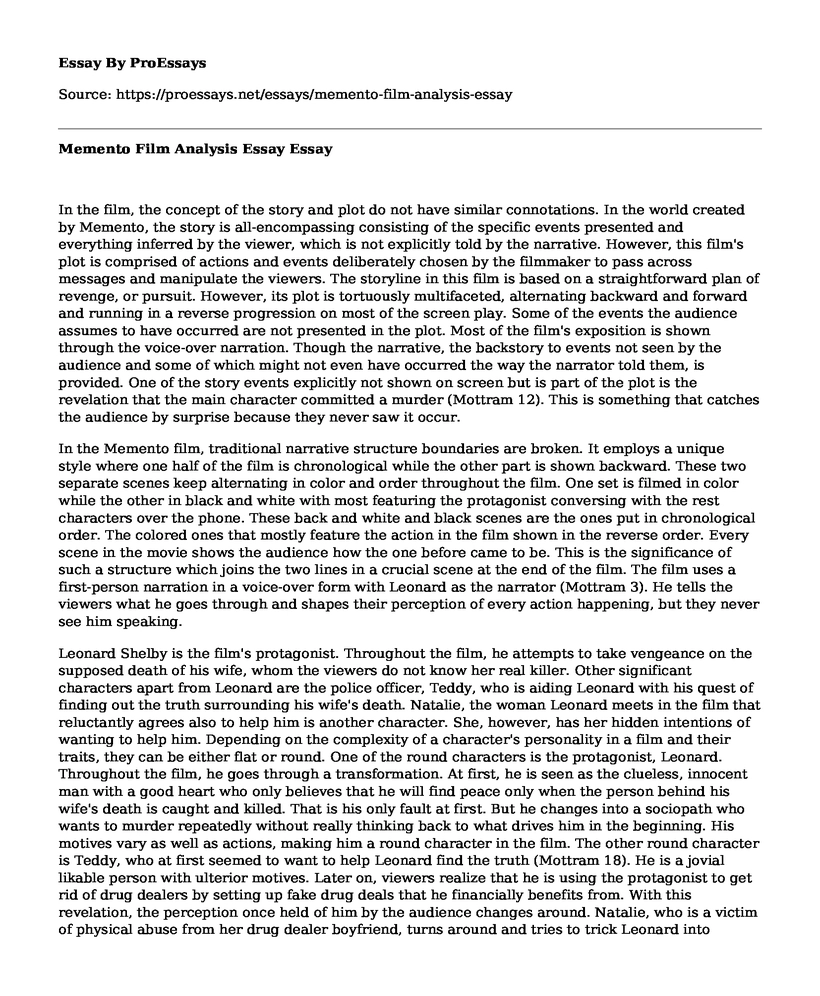In the film, the concept of the story and plot do not have similar connotations. In the world created by Memento, the story is all-encompassing consisting of the specific events presented and everything inferred by the viewer, which is not explicitly told by the narrative. However, this film's plot is comprised of actions and events deliberately chosen by the filmmaker to pass across messages and manipulate the viewers. The storyline in this film is based on a straightforward plan of revenge, or pursuit. However, its plot is tortuously multifaceted, alternating backward and forward and running in a reverse progression on most of the screen play. Some of the events the audience assumes to have occurred are not presented in the plot. Most of the film's exposition is shown through the voice-over narration. Though the narrative, the backstory to events not seen by the audience and some of which might not even have occurred the way the narrator told them, is provided. One of the story events explicitly not shown on screen but is part of the plot is the revelation that the main character committed a murder (Mottram 12). This is something that catches the audience by surprise because they never saw it occur.
In the Memento film, traditional narrative structure boundaries are broken. It employs a unique style where one half of the film is chronological while the other part is shown backward. These two separate scenes keep alternating in color and order throughout the film. One set is filmed in color while the other in black and white with most featuring the protagonist conversing with the rest characters over the phone. These back and white and black scenes are the ones put in chronological order. The colored ones that mostly feature the action in the film shown in the reverse order. Every scene in the movie shows the audience how the one before came to be. This is the significance of such a structure which joins the two lines in a crucial scene at the end of the film. The film uses a first-person narration in a voice-over form with Leonard as the narrator (Mottram 3). He tells the viewers what he goes through and shapes their perception of every action happening, but they never see him speaking.
Leonard Shelby is the film's protagonist. Throughout the film, he attempts to take vengeance on the supposed death of his wife, whom the viewers do not know her real killer. Other significant characters apart from Leonard are the police officer, Teddy, who is aiding Leonard with his quest of finding out the truth surrounding his wife's death. Natalie, the woman Leonard meets in the film that reluctantly agrees also to help him is another character. She, however, has her hidden intentions of wanting to help him. Depending on the complexity of a character's personality in a film and their traits, they can be either flat or round. One of the round characters is the protagonist, Leonard. Throughout the film, he goes through a transformation. At first, he is seen as the clueless, innocent man with a good heart who only believes that he will find peace only when the person behind his wife's death is caught and killed. That is his only fault at first. But he changes into a sociopath who wants to murder repeatedly without really thinking back to what drives him in the beginning. His motives vary as well as actions, making him a round character in the film. The other round character is Teddy, who at first seemed to want to help Leonard find the truth (Mottram 18). He is a jovial likable person with ulterior motives. Later on, viewers realize that he is using the protagonist to get rid of drug dealers by setting up fake drug deals that he financially benefits from. With this revelation, the perception once held of him by the audience changes around. Natalie, who is a victim of physical abuse from her drug dealer boyfriend, turns around and tries to trick Leonard into getting rid of her boss. She is another round character because of the complexity she brings in the plot and how her motives change as the film proceeds. The flat character is the hotel clerk with whom Leonard converses severally. He is given minimal personality and is relatively inefficacious to the film's plot. The film's antagonist is not a person but rather a medical condition Leonard suffers from, amnesia (Mottram 14). It is caused by the head injury he sustained in the assault on him and his wife. It hinders his brain from creating new memories. Amnesia drives him to develop a complex system of reminders and hints. As a way of trying to keep the memories, he tattoos the clues and reminder on his body to keep himself on track.
Works cited
Mottram, James. The Making of Memento. London: Faber and Faber, 2011. Internet resource.
Cite this page
Memento Film Analysis Essay. (2022, Jul 05). Retrieved from https://proessays.net/essays/memento-film-analysis-essay
If you are the original author of this essay and no longer wish to have it published on the ProEssays website, please click below to request its removal:
- Love Just a Coincidence - Movie Description Example
- Film Analysis Essay on 'The Death of Stalin'
- On Drunkenness by Michel De Montaigne - Critical Essay
- Movie Analysis Essay on Pink Boy and Growing Up Trans
- Essay Example on Social Media and TV: How They Impact Criminal Justice in the Digital Era
- Essay Example on War Room: A Director's Journey of Crafting a Masterpiece
- Essay Example on Fashion Merchandising: Success Factors of the Global Market







